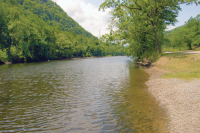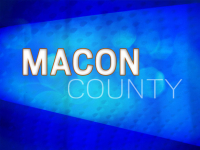Lead contamination found in soil near SCC shooting range
 Results are back from the first round of testing for lead at Southwestern Community College’s shooting range, and the conclusion is that there’s plenty of lead to go around. In the area 15 to 20 feet downslope from the range, lead levels are as much as 73 times higher than the safe amount, occurring in concentrations of 19,700 mg/kg 0 to 6 inches below the surface and 5,320 mg/kg 2 to 3 feet below the surface.
Results are back from the first round of testing for lead at Southwestern Community College’s shooting range, and the conclusion is that there’s plenty of lead to go around. In the area 15 to 20 feet downslope from the range, lead levels are as much as 73 times higher than the safe amount, occurring in concentrations of 19,700 mg/kg 0 to 6 inches below the surface and 5,320 mg/kg 2 to 3 feet below the surface.
“The levels are high. Those are really high levels of lead in the soil,” said Roberta Proctor, an environmental chemist with the N.C. Department of Environment and Natural Resources who is consulting with SCC. “The good news is that the site, it’s got restricted access. It’s not open to the public. There’s no children running through it.”
That’s a comfort, but 19,700 mg/kg is a lot more than 270 mg/kg, which is the Protection of Groundwater Preliminary Soil Remediation Goal established by the North Carolina Inactive Hazardous Sites Branch.
Lead, a heavy metal that can have lethal or debilitating effects when absorbed into the body, is also a key component in bullets. Over 30 years of use, the clay berm that catches bullets fired at the range has taken in an estimated 60 tons of lead, and some of that metal had escaped into the ground downhill from it.
This first round of tests took samples from soil 15-20 feet uphill and downhill from the range, as well as from the water in the Tuckaseegee River, which is just downhill from the range. No lead was found in the uphill samples or in the water, which Proctor says is a good thing.
“Where these samples were collected were not that far from the berm itself, so it’s not like it’s going off site at this point,” she said.
Related Items
Below the sampling spot is a patch of overgrowth, which slows down water running downhill after a rain and keeps it from picking up as much soil. No lead was found in the water, but it could be in the sediment below the water, bonded to the dirt. But in any case, the metal is now staying stuck to the dirt, which means it’s not moving too far.
“You have water running down the stream and in a really heavy rain it gets really muddy, but all that mud settles down,” Proctor said. “The lead is attached to the soil so it’s not moving off-site as far.”
What’s more, lead is only toxic if it’s ingested or inhaled, so basically unless someone were actually eating the dirt or plants growing in it, rubbing it into a wound or breathing it in, they probably wouldn’t suffer any effects from the current levels, Proctor said. Because the area is not open to the general public, the groups most likely to be affected by lead exposure — children and elderly people — wouldn’t come in contact with it.
But that doesn’t mean that it’s all peachy.
“It is an exposure to the environment out there, which is why it can’t just stay there,” Proctor said. “Anything that grows in it will pick up and incorporate the lead into it. Different plants do it at different rates.”
After Proctor first visited the site, about six weeks ago, SCC staff installed sediment traps to keep any more contaminated soil from flowing away. The traps are made out of large rocks that act as dams, keeping soil from moving downslope.
But now that the sampling results have come back, SCC has some work cut out. The college has already contacted Canton-based Mountain Environmental Services, who did the first round of testing, for a proposal on a second round to see how far downhill the contamination has spread. Then, SCC will remove any contaminated soil that is outside of the actual shooting range.
They won’t, however, remove any lead from the range itself yet. Because the lead is encased in clay, it’s difficult to remove and would cost $30,000 to excavate, even after the contracting company offset the price by selling the metal. And once the lead was gone, it would just start building back up again.
“Right now we’re just shooting into the dirt bank, so obviously we’re going to have an accumulation of lead and no really easy way to get it out,” said Chuck Reece, director of human resources and facilities at SCC.
Before anyone thinks about taking the 60 tons out of the berm, there will have to be a better berm, which points back to the origin of the whole lead testing discussion.
It began after SCC leaders came to Jackson County Commissioners with a request for money to install a new backstop at the range. The berm had gotten so full of bullets that shots were beginning to ricochet back when fired.
“The issue that we started with was we’ve got too much lead in the backstop, not from an environmental standpoint but just from a safety standpoint,” said Daniel Manring, coordinator of administrative and facilities projects for SCC.
SCC came up with an array of options for fixing the problem, ranging from $368,000 to install the most inexpensive bullet trap proposed for the backstop to $725,000 for the most expensive. Additional asks to fix up the range, including a new entrance that would keep range users from having to drive through the Tuckasegee Water and Sewer Authority plant, would have upped the price as high as $2 million.
SCC is still in limbo as far as that’s concerned, so current efforts are just focused on investigating the extent of the contamination and addressing dangerous levels.
“I’ve been contacted by at least three companies that do lead abatement, and I just told them to keep checking in with me when we find out what we can do dollar-wise,” Manring said.
Though Proctor said she was not at all surprised to see the test results, she commended SCC for having them done in the first place. As an active shooting range, they weren’t required to undergo environmental testing and contacted DENR to request it.
“When you have somebody who has a contaminated site and is working with you as opposed to your forcing them to work, it makes it very different,” she said. “They’re very willing and able to do what they need to do, and that makes everything so much easier.”













